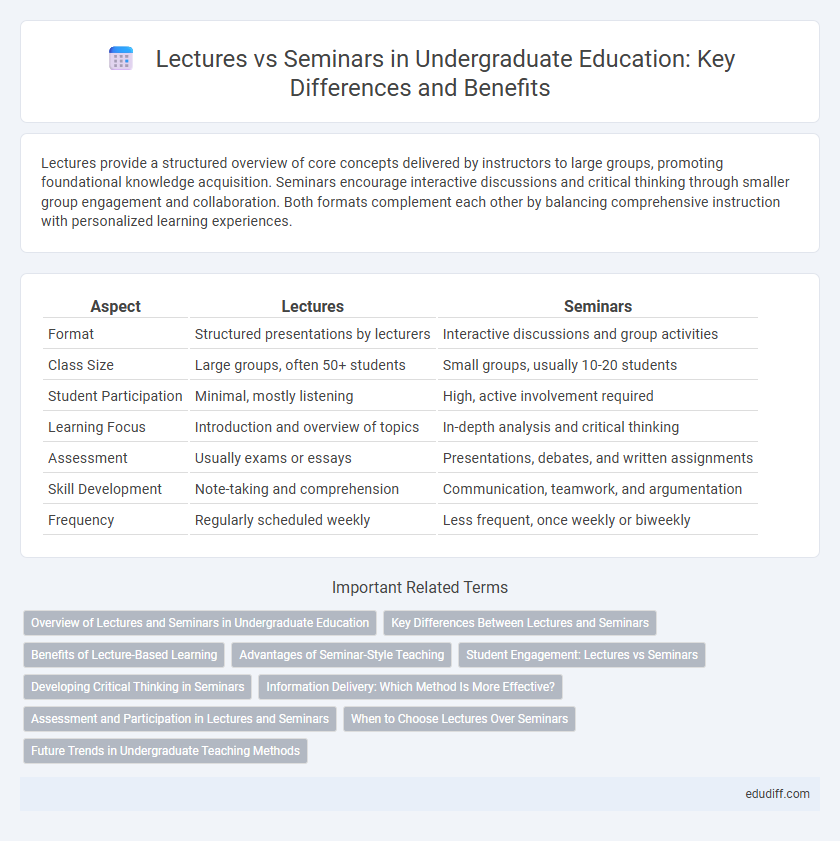Lectures provide a structured overview of core concepts delivered by instructors to large groups, promoting foundational knowledge acquisition. Seminars encourage interactive discussions and critical thinking through smaller group engagement and collaboration. Both formats complement each other by balancing comprehensive instruction with personalized learning experiences.
Table of Comparison
| Aspect | Lectures | Seminars |
|---|---|---|
| Format | Structured presentations by lecturers | Interactive discussions and group activities |
| Class Size | Large groups, often 50+ students | Small groups, usually 10-20 students |
| Student Participation | Minimal, mostly listening | High, active involvement required |
| Learning Focus | Introduction and overview of topics | In-depth analysis and critical thinking |
| Assessment | Usually exams or essays | Presentations, debates, and written assignments |
| Skill Development | Note-taking and comprehension | Communication, teamwork, and argumentation |
| Frequency | Regularly scheduled weekly | Less frequent, once weekly or biweekly |
Overview of Lectures and Seminars in Undergraduate Education
Lectures in undergraduate education deliver structured content to large groups, emphasizing core theories and foundational knowledge across disciplines. Seminars promote interactive learning through discussions, critical analysis, and student engagement in smaller groups, enhancing comprehension and practical application. Both formats complement each other by balancing information delivery and active participation to deepen academic understanding.
Key Differences Between Lectures and Seminars
Lectures primarily involve one-way communication where an instructor delivers information to a large group of students, focusing on content dissemination and foundational knowledge. Seminars foster interactive discussions among smaller groups, encouraging critical thinking, debate, and deeper exploration of topics through active student participation. The key differences include the size and format of sessions, level of student engagement, and the balance between information delivery and collaborative learning.
Benefits of Lecture-Based Learning
Lecture-based learning offers a structured delivery of comprehensive subject content, enabling students to absorb key concepts from expert instructors efficiently. This method benefits large groups by providing standardized information and promoting consistent foundational knowledge across the cohort. Additionally, lectures facilitate note-taking and real-time clarification, enhancing retention and understanding of complex material.
Advantages of Seminar-Style Teaching
Seminar-style teaching promotes active student engagement through discussions, fostering critical thinking and deeper comprehension of complex topics. This interactive approach encourages collaboration and exchange of diverse perspectives, enhancing analytical skills and knowledge retention. Smaller group settings in seminars allow for personalized feedback and more direct interaction with instructors, improving the overall learning experience.
Student Engagement: Lectures vs Seminars
Lectures typically involve passive student participation, where information is delivered by the instructor to a large group, limiting interactive engagement. Seminars promote active student involvement through discussions, debates, and collaborative activities that enhance critical thinking and deeper understanding of the subject matter. Research indicates that seminars increase student motivation and retention by fostering a more dynamic and personalized learning environment.
Developing Critical Thinking in Seminars
Seminars foster critical thinking by encouraging active student participation, collaborative discussions, and analysis of diverse perspectives, contrasting with lectures which primarily deliver information passively. The interactive format of seminars enhances reasoning skills, deeper understanding, and the ability to synthesize complex ideas through dialogue and feedback. This dynamic environment cultivates independent thought essential for academic success and professional development in undergraduate studies.
Information Delivery: Which Method Is More Effective?
Lectures efficiently deliver comprehensive information to large undergraduate groups by utilizing a structured presentation format and visual aids, enhancing content absorption. Seminars, offering interactive discussions and personalized feedback, promote deeper understanding through active student participation and critical thinking exercises. Comparing effectiveness depends on the learning objectives, where lectures prioritize broad content coverage while seminars emphasize analytical skills and knowledge application.
Assessment and Participation in Lectures and Seminars
Lectures primarily assess students through written exams and quizzes that test comprehension of delivered content, while seminars evaluate participation through discussions, presentations, and group work, emphasizing critical thinking and communication skills. Active participation in seminars contributes significantly to final grades, reflecting students' engagement and ability to apply concepts in collaborative settings. Lectures often have less direct participation grading, focusing instead on the absorption of information presented.
When to Choose Lectures Over Seminars
Lectures are preferable when large groups require foundational knowledge delivery efficiently, as they enable professors to present structured content to many students simultaneously. Choosing lectures suits situations where the focus is on theory, broad concepts, or standardized information that does not demand immediate interaction or personalized feedback. For undergraduates needing clear, concise overviews of complex topics before deeper engagement, lectures serve as an effective starting point over smaller, discussion-based seminars.
Future Trends in Undergraduate Teaching Methods
Future trends in undergraduate teaching methods emphasize interactive and technology-driven learning environments, shifting from traditional lectures to seminars that foster critical thinking and collaboration. Seminars offer personalized engagement, enabling deeper exploration of topics through discussion-based formats and increased student participation. Integrating digital tools like virtual reality and AI-powered platforms enhances seminar experiences, making future undergraduate education more immersive and adaptable to diverse learning styles.
Lectures vs Seminars Infographic

 edudiff.com
edudiff.com